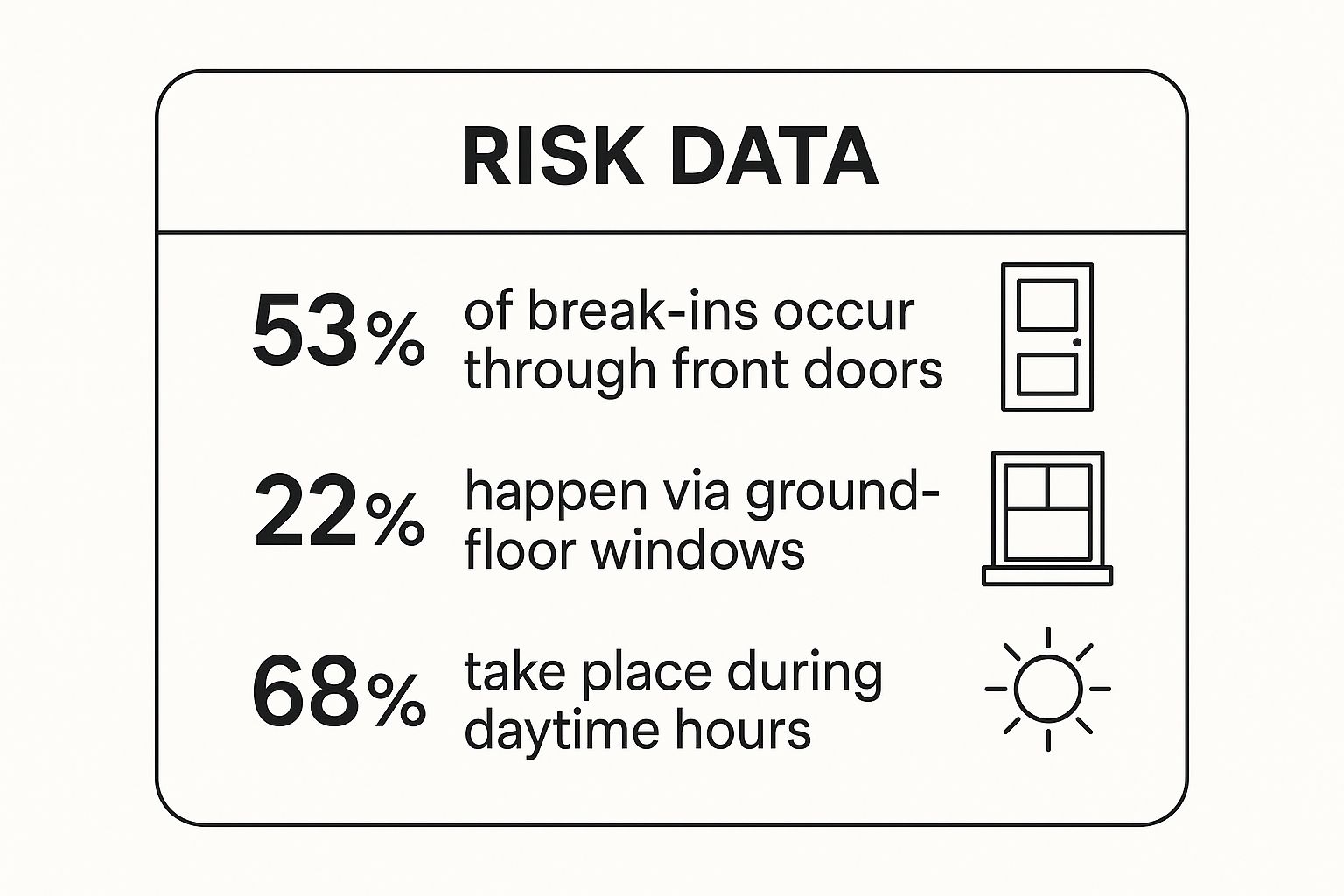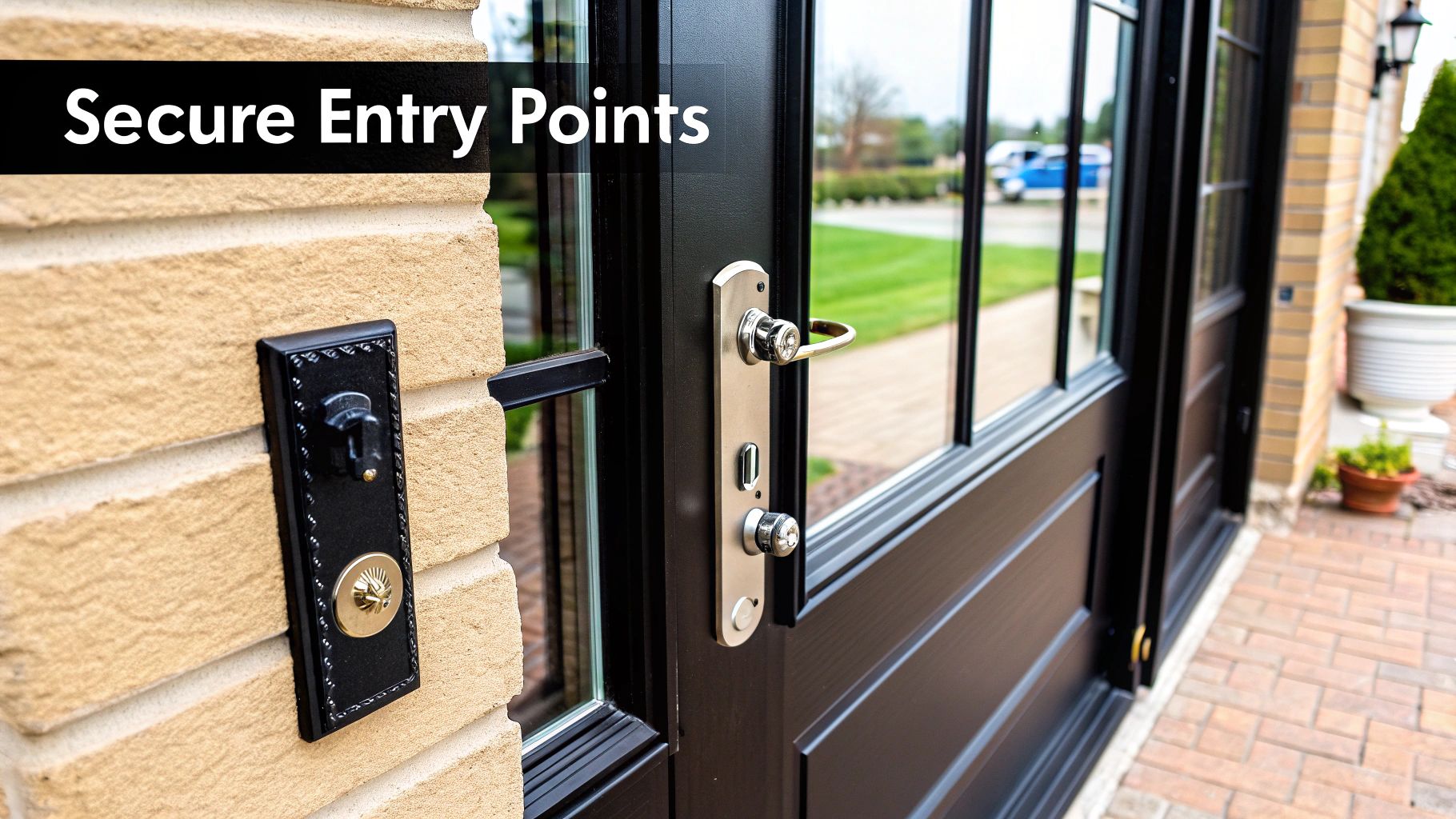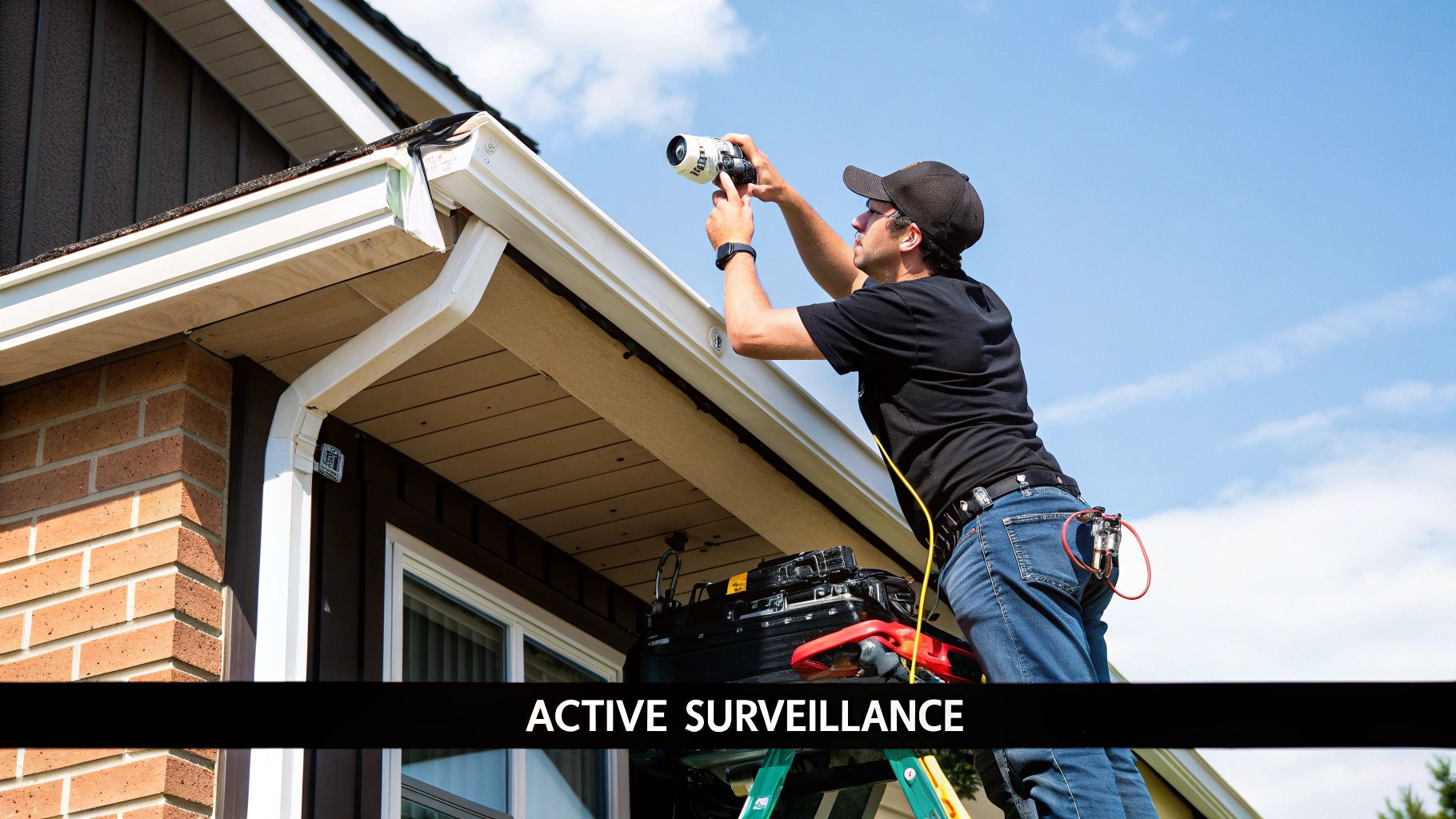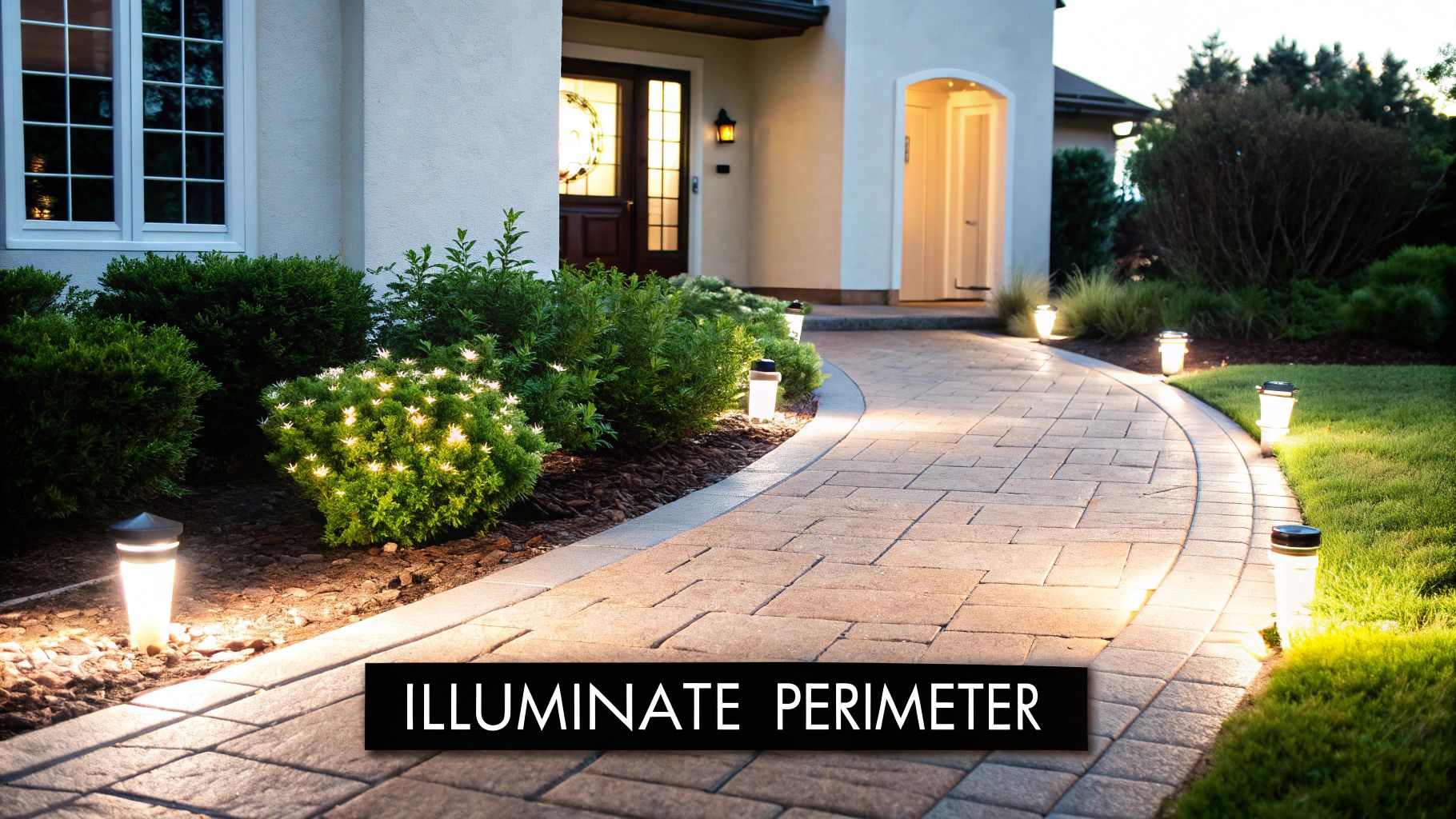How to Prevent Break Ins A Practical Guide
- Бонус за регистрацию онлайн казино
- Sep 12
- 13 min read
When it comes to stopping a break-in, you need to think in layers. It's not just about one single gadget or a strong lock; it's about combining physical barriers, smart tech, and just plain good habits. The best strategies reinforce your doors and windows, use cameras and alarms to scare off potential intruders, and make your home look like someone's always there.
Understanding Your Home's Vulnerabilities
Real home security is all about creating multiple hurdles for a potential burglar. Think of it this way: if a thief encounters one obstacle, they might try to get past it. But if they run into a series of them—a reinforced door, a highly visible camera, and then a blaring alarm—the odds are they'll just give up and look for an easier target. This layered approach is hands-down the most reliable way to prevent break-ins.
This guide will walk you through building those layers, from simple hardware store upgrades to getting the most out of modern security technology. The goal is to weave these elements together into a solid strategy that shores up your home's weakest spots.
These layers all work in concert to create a pretty tough defense:
Physical Barriers: This is your first line of defense. We're talking reinforced doors, better window locks, and even strategic landscaping.
Technological Deterrents: This layer is about actively discouraging criminals with things like visible security cameras, bright motion-activated lights, and loud alarm systems.
Behavioral Habits: This is the human element. Your daily routines—like always locking your doors and making the house look lived-in when you're gone—are a surprisingly powerful, and often overlooked, security layer.
Where Break-Ins Happen Most
To protect your home effectively, you first have to know where thieves are most likely to strike. The data is pretty clear on the most common entry points.

What these numbers tell us is that intruders aren't masterminds picking complex locks in the dead of night. They often take the path of least resistance, right through the front door, and frequently do it in broad daylight when they assume no one is home. This really highlights why securing your main entry points and having a visible deterrent is so important.
Here's a quick overview of how these different security layers fit together.
Key Layers of Home Security at a Glance
Security Layer | Primary Goal | Examples |
|---|---|---|
Physical Barriers | Make it physically difficult and time-consuming to enter. | Deadbolt locks, reinforced door frames, window security film, thorny bushes. |
Technological Deterrents | Alert you to threats and scare off intruders before they get inside. | Security cameras, motion-sensor lights, audible alarm systems, smart doorbells. |
Behavioral Habits | Create the impression of an occupied and vigilant home. | Locking doors/windows, using light timers, managing mail delivery, not advertising vacations. |
This table provides a snapshot of the core components we'll be exploring. Each layer supports the others, creating a much stronger defense than any single measure could provide on its own.
Even though burglary rates have seen a general decline over the years, residential break-ins are still a major concern. In 2023, FBI data revealed that homes were the target in a staggering 52.8% of all burglary offenses. What's really shocking is that over a third of those were unforced entries—meaning the intruder just waltzed in through an unlocked door or window. You can learn more about these home security trends and statistics to see just how critical it is to secure every single access point.
Bolstering Your Home’s Weakest Links
Most burglars are looking for an easy score. They're not master criminals; they're opportunists searching for the path of least resistance. That means your doors and windows are their first stop, and unfortunately, just locking them isn't always going to cut it. To truly prevent break-ins, you have to turn these weak spots into genuine obstacles.

Think about it this way: a standard door lock can often be defeated with a single, forceful kick. I've seen it happen. The lock itself isn't usually what fails—it's the flimsy, short screws holding the strike plate to the soft wood of the door frame. One good shove and the frame splinters, making the lock completely useless. This is exactly why a few smart, simple upgrades can make all the difference.
Reinforcing Your Doors
Let's start with your main entry door, since it’s the most common target. Your first move should be to install a high-quality deadbolt. Look for one with at least a 1-inch throw, which is how far the metal bolt extends into the door frame. That extra length makes it significantly harder for someone to pry the door open.
But the lock is only half the battle. The real secret is strengthening the door frame itself. Throw away the standard strike plate that came with your lock and get a heavy-duty, reinforced one. Here’s the crucial part: install it with 3-inch screws. These long screws bypass the weak door jamb and anchor directly into the solid wall stud behind it. This single, inexpensive trick dramatically increases how much force the door can withstand.
Pro Tip: A reinforced strike plate anchored with long screws is hands-down one of the most cost-effective and powerful security upgrades you can make. It transforms a flimsy door into a real barrier.
Don't stop at the front door. What about the door leading into your house from the garage? These are often overlooked and less secure, giving intruders a hidden place to work. You need to apply the same reinforcement techniques to every single entry point to be truly secure. These kinds of structural upgrades, along with other essential home safety modifications, create a much safer living space overall.
Locking Down Your Windows
Windows, especially on the ground floor, are another huge vulnerability. You lock them, of course, but the glass is still an obvious weak point. An excellent way to counter this is by applying a security film. It's a clear polyester sheet that adheres to the glass, holding it together even if it's shattered. A burglar can't just punch a clean hole through it to unlock the window and climb in.
Sliding glass doors and windows are notorious for having flimsy factory latches. I never trust them. A simple, old-school solution works wonders here: a "Charley bar" or a pinning lock. A Charley bar is just a sturdy metal rod that you place in the track, physically preventing the door or window from sliding open. A pinning lock is a bit more involved—you drill a small hole through both the sliding frame and the stationary one and then insert a steel pin. Both methods add a solid physical block that standard latches just can't match.
Using Technology as a Powerful Deterrent
Physical barriers are a solid first line of defense, but today's technology lets you be proactive. It's about more than just catching a burglar; it's about convincing them to skip your house entirely. Smart security tools create a powerful visual deterrent that makes your property a much harder, less appealing target from the get-go. By weaving together cameras, alarms, and intelligent lighting, you create a security ecosystem that actively protects you.

It’s surprising how many homes are left completely exposed. Recent data shows that nearly half (46.9%) of American residents don’t have any kind of home security system. The same study revealed what homeowners value most for prevention: visible cameras (32.3%) and motion-activated floodlights (24.5%). If you want to dive deeper, the 2025 home invasion statistics offer some great insights into what people are concerned about.
This all points to one simple truth: making your home look protected is a massive step in keeping it safe.
Strategic Camera Placement
Don’t just stick a camera over the front door and call it a day. Burglars are experts at finding blind spots and overlooked entry points. To be effective, you need to think like one and cover the real vulnerabilities.
Where would you try to break in if you didn't want to be seen?
Secondary Doors: The back door, side entrances, and especially the door leading in from the garage are classic targets.
Ground-Floor Windows: Think about the windows at the back or side of the house, often hidden by bushes or fences.
Access Gates: Any gate that leads into your backyard or side yard is a potential entry point that needs watching.
A camera on the driveway is a good start, but a camera angled to see both the side gate and the back windows provides exponentially more security. The real goal here is to eliminate any hidden approach to your home, sending a clear message that every angle is monitored.
The best security camera setups don't just record—they announce their presence. A visible, well-placed camera is often all it takes for a would-be thief to decide your neighbor’s house is an easier target.
Understanding Alarm Systems
There's nothing quite like a blaring alarm to ruin a burglar's day. It's a powerful psychological weapon that creates chaos, draws attention, and screams that the clock is ticking. When you're looking at alarms, your biggest choice is between a monitored and an unmonitored system.
Unmonitored Systems: Think of these as standalone alarms. When they go off, a loud siren and flashing lights activate. They're designed to scare off the intruder and hope a neighbor (or you) hears it and calls for help.
Monitored Systems: These are connected 24/7 to a professional monitoring center. When a sensor trips, an agent is alerted. They’ll try to contact you first, and if they can't, they'll dispatch emergency services for you. It's a huge peace-of-mind upgrade.
For either type, make sure the system includes door and window sensors. These little devices are the backbone of any good setup. They trigger the alarm the second a door or window is opened, stopping an intruder right at the perimeter before they even get a foot inside.
Smart Lighting for Active Deterrence
A dark, shadowy property is practically a welcome mat for criminals. Smart lighting, especially motion-activated floodlights, is one of the easiest and most effective deterrents out there. A sudden blast of bright light is jarring, and it instantly exposes anyone trying to sneak around.
Install these lights over key areas like driveways, back patios, and side yards. But don't stop there. Use smart bulbs or plugs inside your house to create the illusion that someone's home. You can set a schedule for lights to pop on and off in different rooms throughout the evening. This simple trick can make a prowler second-guess their assumption that the house is empty and move on.
Making Your Property Look Like a Hard Target
It’s not just about locks and alarms. A huge piece of preventing break-ins is pure psychology. Burglars are, at their core, opportunists looking for the path of least resistance. Your job is to make your property look like a complicated, high-risk headache they’d be smart to avoid.
You want your home to scream "move along" before they even think about testing a doorknob.

This entire strategy hinges on perception. Simple, visual clues can instantly signal that your home is occupied, watched, and just not worth the trouble. The best part? Many of these tweaks cost next to nothing but can completely change a prowler's mind.
Strategic Landscaping and Maintenance
Your yard is either a welcome mat for intruders or a major deterrent. Overgrown bushes right up against the house? That’s a perfect hiding spot, especially near ground-floor windows and doors. The goal should always be a clear line of sight from the street to your home.
Keep shrubs trimmed down below windowsill height. I often recommend planting something thorny like holly or barberry under windows. It creates a painful, natural barrier that makes climbing in a lot less appealing, and it doesn't make your home look like a fortress.
A tidy, well-kept lawn also sends a powerful message. It tells a potential burglar that the people inside are attentive and on top of things, which strongly suggests they’re just as serious about their security.
Key Takeaway: A property that looks cared for and visible from the street is a less appealing target. Criminals love concealment and signs of neglect because it implies an easy, unmonitored prize.
Simulating an Occupied Home
There's nothing a burglar loves more than an empty house. The most effective way to protect your home when you’re away—whether for an afternoon or a two-week vacation—is to make it look like someone’s there. This is where a little automation can be a game-changer.
Smart Light Timers: Don't just leave one porch light on 24/7. That's a dead giveaway. Instead, use multiple smart plugs or timers to have lamps in different rooms—the living room, a bedroom—flicker on and off at varied, natural-looking times in the evening.
A Little Background Noise: A radio or TV on a timer can work wonders. The muffled sound of voices or music from outside is an incredibly strong signal that someone is home and awake.
Beyond creating the illusion of being home, you want to eliminate any dark corners where someone could lurk. This is where you should look into effective outdoor lighting techniques to really brighten up your property's perimeter.
The Power of Visual Deterrents
Never, ever underestimate the power of a simple yard sign. In one study, the vast majority of convicted burglars admitted they would check for an alarm system before hitting a house. If they saw any indication of one, most said they would just skip it and find an easier target.
Placing a security system sign in your front yard and a few decals on your windows is a simple but surprisingly effective tactic. It doesn't even matter if you have a state-of-the-art system. These visual cues plant a seed of doubt. The burglar is forced to ask, "Is it worth the risk?" And more often than not, the answer is no.
Weaving Security into Your Daily Life
All the high-tech security gear in the world won't do much good if you don't use it consistently. Technology gives you the tools, but your daily habits are what truly lock down your home against intruders. It's about creating a culture of security in your household until it becomes second nature.
This all starts with a simple but non-negotiable nightly "lock-up" routine. Before you turn in for the night, just take a quick two-minute walk through your home. Check every single potential entry point. Are all the doors deadbolted? Are the ground-floor windows latched shut? Is the garage door completely closed and secured? Making this a rock-solid habit for everyone in the house closes the single biggest loophole burglars look for: an unlocked door.
Think Before You Post
In today's world, a burglar doesn't always have to drive by your house to see if you're home. Sometimes, all they need to do is scroll through their social media feed. Broadcasting your vacation plans with real-time updates from the airport or the beach is basically putting up a giant sign that says, "My house is empty this week."
It's a simple fix: wait until you're back home to post all those amazing trip photos. This small delay keeps you from advertising your absence to a very wide, and potentially untrustworthy, audience. It's a tiny shift in your habits that can have a massive impact on keeping your home off a burglar's list.
A locked door might stop an opportunist, but a quiet social media feed keeps your home from ever getting on their radar. Don't underestimate the power of the information you share publicly.
As you get into the rhythm of these new routines, remember that special occasions often demand extra attention. The holidays, for instance, are a prime time for travel and distractions, leaving homes more vulnerable. You can find some specific tips for preventing holiday season home burglaries that are especially useful during that time of year.
Your Community Is Your Best Alarm System
At the end of the day, technology can't replicate the power of a good, old-fashioned vigilant community. Honestly, getting to know the people who live next door is one of the most effective security measures you can possibly take. When neighbors look out for each other, you create a network of eyes and ears that can spot suspicious activity far better than any single camera ever could.
Even a simple understanding can make a world of difference:
Mail & Package Watch: If you're heading out of town, ask a neighbor you trust to grab your mail, newspapers, and any packages that get delivered. A pile of boxes on the porch or an overflowing mailbox is a dead giveaway that nobody's home.
A Heads-Up: Let a neighbor know when you'll be away and give them your number. They can keep an eye out for unfamiliar cars or people lurking around your property and give you a call if something seems off.
This kind of collective awareness turns a street of separate houses into a truly united front. It creates a powerful deterrent that technology, on its own, just can't match.
Common Questions About Preventing Break-Ins
It’s completely normal to have a few lingering questions, even after you’ve put a solid security plan in place. Getting straight answers helps you feel confident that you’re putting your time and money into the right solutions. Let’s walk through some of the things people often ask when they’re working on securing their homes.
Is a Professionally Monitored Alarm System Really Worth the Monthly Fee?
This is probably the biggest question on everyone’s mind, and for good reason. Is the monthly cost really worth it? For most people, the answer is a definite yes.
While a DIY system is a great start and certainly better than nothing, a monitored system adds a critical layer of protection. Think of it as a safety net. If a sensor goes off while you're on vacation, stuck in a meeting, or just can't get to your phone, a professional is already on it, dispatching help. That peace of mind is invaluable.
Do I Really Need Cameras if I Already Have an Alarm?
This comes up a lot, too. People wonder if cameras are overkill when they already have a good alarm. The key is to understand that they do two very different, but equally important, jobs.
An alarm tells you that something happened. A camera shows you what happened. It gives you visual proof, helps police identify who was on your property, and can be a game-changer for an investigation. Honestly, a clearly visible camera is one of the most powerful deterrents you can have—it makes would-be intruders feel watched before they even make a move.
What About Fake Security Signs and Dummy Cameras?
Ah, the old dummy camera trick. Does it actually work? The answer is… sometimes. A fake sign or a decoy camera can definitely make an opportunistic thief think twice. Most convicted burglars say they would skip a house if it looked like it had any security at all. They’re after an easy score, and anything that hints at surveillance adds risk.
But here’s the catch: a more seasoned criminal can often spot a fake. Dummy cameras usually don't have the small details of real ones, like a subtle status light or realistic wiring. So, while they’re a decent low-cost starting point, they can’t replace the real protection and evidence you get from a genuine system. It’s best to think of them as one small piece of the puzzle, not the whole solution.
I Have a Big Dog. Isn't That Enough?
A big dog with a booming bark is an incredible deterrent. No question about it. That noise alone is often enough to make an intruder turn right around and leave. For a burglar, a dog is a huge unknown—they have no idea if it will attack, and they certainly don't want the entire neighborhood to hear it barking.
However, you can't rely only on your four-legged security guard. A determined intruder might try to distract, lure, or even harm your dog. The best approach is to let your dog’s protective instincts work alongside other security layers, like strong doors, secure windows, and a reliable alarm.
The hard truth is that stopping a break-in before it starts is the only real win. Law enforcement only manages to solve about 12% of reported burglaries. As you can see from these burglary case statistics, that low clearance rate means stolen belongings are rarely recovered and the people responsible are seldom caught.
Ultimately, a layered defense is always the most effective strategy. No single gadget or tactic is perfect, but when you combine physical reinforcements, smart technology, and good daily habits, you make your home a much, much harder target.
At PCI Audio-Video Security Solutions, we focus on building complete security strategies that protect what's most important to you. We design and install everything from advanced 4K security cameras and access control systems to professional-grade alarms that offer true peace of mind. You can explore our solutions and secure your property with confidence at https://www.pciavss.com.







Comments